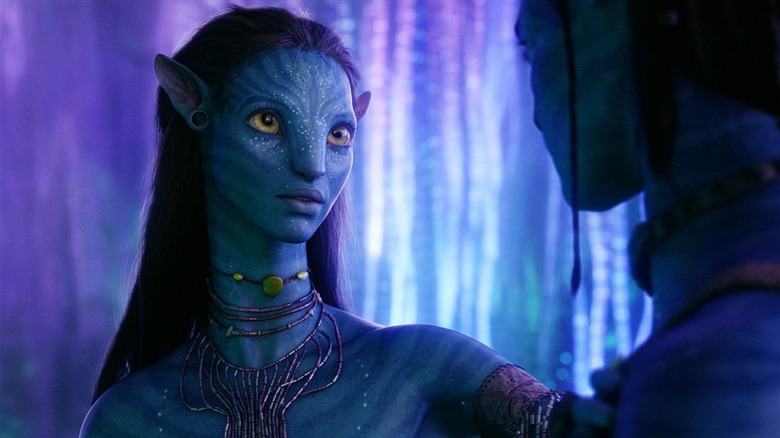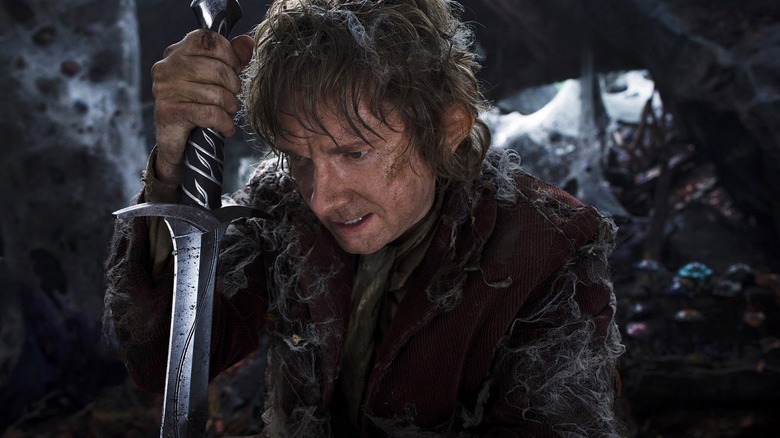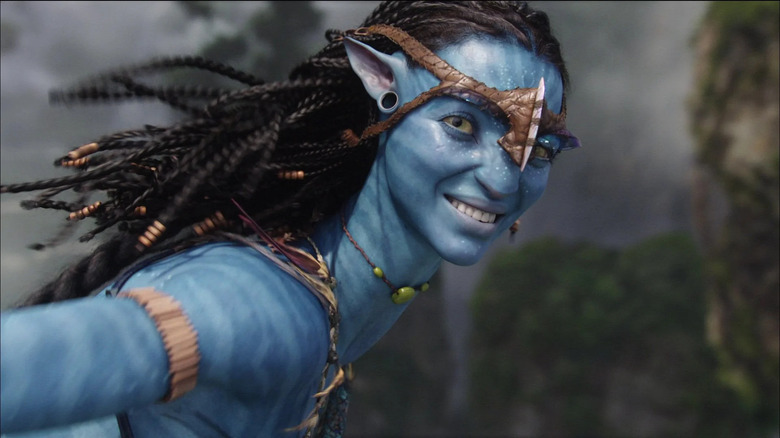How Avatar's Remastered Re-Release Was Enhanced By This New Technology
Over the weekend of September 23, James Cameron's 2009 ultra-blockbuster "Avatar" was re-released in theaters with a brand new visual remastering. Some theaters might have advertised that "Avatar" was to be projected in 4K, but little else might have been revealed in terms of the remastering technicals. The new version certainly looks better, but the improvement did not involve any new animation or rendering. It was all thanks to a new kind of motion adjustment technology called TrueCut Motion. Thanks to a recent visit to Pixelogic studios in Burbank, CA, /Film was made privy to the fineries of TrueCut Motion, and what exactly a team of hard-working technicians were doing to improve the visuals of the already visually complex "Avatar."
To start with an analogy: Imagine it's the year 2006, and you still own a cathode ray tube TV. You have a DVD player, and all your favorite movies look great on DVD. Indeed, the Criterion Collection has optimized DVD technology so that it looks as good as possible on a CRT TV. Then Blu-rays hit the market and you are eager to check them out. You play a Blu-ray on your CRT TV, and, darn it, it doesn't seem to look much better than your DVDs. It won't be until you also buy a flat-screen, 2K digital TV that you'll notice a significant difference between DVDs and Blu-rays. All of a sudden, way more visual information is on your screen.
The inflection point
Cinema has reached a similar inflection point, and the people at TrueCut Motion are aware of it. Modern digital film cameras can now shoot at higher frame rates and contain more visual information than ever. But when that new store of visual information is projected through a standard theater projector, it causes some visual issues. 24 frames per second, it seems, is now no longer adequate to handle the crisper, sharper, digital films like "Avatar." In brief, the presentation technology is lagging behind the production technology.
The resulting visual error caused between the technological mismatch is something that the technical experts called "judder." Judder, seemingly a portmanteau of jitter and shudder, is something a viewer might notice when a film camera pans horizontally across a picket fence, or whips quickly through a house interior. The image takes on a jumpy, jerky quality. This is not the same as a motion blur, like one might see on a quick pan on 35mm film, but a visual "rattle." The above video, taken from "G.I. Joe: Retaliation," is a good example of what judder looks like.
On digital TVs, such judder can be reduced by adjusting the ever-maligned motion blur option. The problem with motion blur is it doesn't so much fix the visual problem as cover it up with a new one. Motion blur, essentially, adds artificial mushiness to moving images in an attempt to blend one frame with the next. The result is an unnatural, weird-looking smoothness that rarely looks good.
High frame rate
The obvious solution for judder is to shoot films at a higher frame rate than 24 frames per second. Ever since the introduction of synchronized sound into cinema a century ago, the decision was made to run film at a standard 24 fps. It was the least number of frames filmmakers could get away with while still retaining a convincing illusion of movement. 24 fps was an economic decision. In recent years, filmmakers like Peter Jackson and Ang Lee have experimented with higher frame rates in films like "The Hobbit: An Unexpected Journey" and "Gemini Man."
The general consensus on the high frame rates, however, was that the image was too smooth. Everything looked cheaper or artificial, like a news program. Video games and reality TV are shot in higher frame rates than feature films, and audiences immediately associated the HFR aesthetic with low-budget TV shows. There was no judder in "The Hobbit," but without the default "cinematic" 24 fps, it just didn't look like a movie. Perhaps someday, audiences will accept a new motion aesthetic for cinema, but "The Hobbit" wasn't the film to do it.
The people at the TrueCut Motion studios certainly heard the criticisms about "The Hobbit," but they also understood that 48 fps was still going to be the ideal way to assure a smoother, better filmic motion with the projection technology available. As such, they sought to improve cinema's visuals by creating a 48 fps master, but improved by their own technical flair to make 48 fps look more acceptably "cinematic" to the eye.
It is here, finally, that TrueCut Motion comes into play.
TrueCut Motion
What TrueCut Motion did for "Avatar" was twofold. Firstly, using a very complicated mapping and visual creation technology, they converted the film from 24 fps — how it was shot — into 48 fps. Then, using their adjustable technology, they added a certain kind of visual blending that balanced the cinematic "heft" of a classic piece of cinema with the oily smoothness of a 48 fps presentation. This is not the same as motion smoothing, but a new kind of total visual alteration. The judder is eliminated, and so too is the soap opera aesthetic of a "Hobbit" movie.
To date, the Pixelogic team has only been tinkering with recent, digitally shot movies, so further experiments with older movies shot on 35mm film haven't been done just yet. As projectors continue to evolve, however, movies may soon reach a point where a digitally rendered classic may not look as good on the big screen as it once did. The medium changes, and remastering is suddenly required. There may come a day when "Citizen Kane" will be enhanced into 48 fps and granted the same TrueCut Motion treatment.
And before any purists get huffy about the violation of a director's intent, understand that it's the best way to retain visual fidelity. Orson Welles likely didn't want his film seen on a big screen with a distracting digital shimmer to it, either. TrueCut Motion is here to help cinematic motion evolve.
The result looks pretty great. It's a good way to hold audience's hands and guide them more gently into high frame rates, and it's a visual compromise between movies and TV. Anyone who saw "Avatar" over the weekend can attest to its strength.


